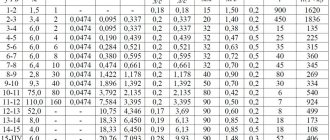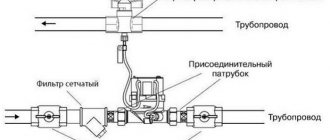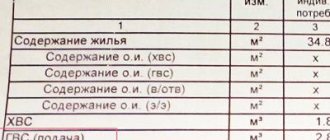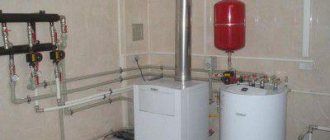Why do residents of neighboring houses pay different amounts for heat?
This problem arose with the introduction of various payment methods - by quadrature (standard), by a common meter or by individual heat meters. If you looked through the previous sections of the publication, you probably noticed the difference in the monthly fee. The fact is explained quite simply: if there are measuring instruments, residents pay for the resource actually used.
Now let's list the reasons why landlords receive bills with different amounts, despite the heat meters installed in their houses:
- Heating of two neighboring buildings is carried out by different heat supply organizations, for which different tariffs are approved.
- The more apartments there are in a house, the less you can pay. Increased heat loss is observed in corner rooms and dwellings on the top floor, the rest border on the street only through 1 external wall. And such apartments are the vast majority.
- One meter at the entrance to the house is not enough. A flow regulator is required - manual or automatic. The fittings allow you to limit the supply of too hot coolant, which is a common sin for heat supply organizations. And then they charge the appropriate fee for the service.
- The competence of the management chosen by the co-owners of an apartment building plays a big role. A competent business manager will solve the issue of accounting and regulating the coolant first.
- Uneconomical use of hot water heated by coolant from a centralized network.
- Problems with metering devices from different manufacturers.
Please note that the following notations and concepts will be used in this article:
IPU - individual metering device;
ODPU - a common building (collective) metering device installed in an apartment building;
Residential premises in an apartment building - apartment;
Non-residential premises in an apartment building are various shops, offices, parking spaces, underground garages and parking lots, and so on, located in an apartment building .
The calculation methods and examples presented below provide an explanation of the procedure for calculating the amount of heating fees for residential premises (apartments) located in apartment buildings that have centralized systems for supplying heat energy - a centralized heat supply system .
Final Conclusion
There are many reasons for large heating bills. Obvious: a building with thick brick walls loses less heat than reinforced concrete “nine-story buildings.” Hence the increased energy consumption recorded by the meter.
But before you undertake the modernization (insulation) of the building, it is important to establish control and accounting - install heat meters in all rooms and on the supply line. The calculation methodology shows that such technical solutions give the best results.
Options for calculating the heating fee:
Calculation No. 1 The amount of payment for heating in a residential building (apartment), in an apartment building the thermal energy budget has not been established ; payment for heating is carried out during the heating period (formula 2(3)) . Read about the procedure and example of calculation →
Calculation No. 2 The amount of payment for heating in a residential premises (apartment), the ODPU in an apartment building has not been established; the ODPU for thermal energy is not established ; payment for heating is carried out during the calendar year (12 months) (formula 2(4)) . Read about the procedure and example of calculation →
Calculation No. 3 The amount of payment for heating in a residential premises (apartment) , in an apartment building an ODPU is installed , there are no individual heat meters in all residential and non-residential premises , payment for heating is carried out during the heating period (formula 3) . Read about the procedure and example of calculation →
Calculation No. 3-1 The amount of payment for heating in a residential premises (apartment) an ODPU is installed in an apartment building , there are no individual heat energy meters in all residential and non-residential premises , payment for heating is carried out evenly throughout the calendar year (12 months) (formula 3) . Read about the procedure and example of calculation →
Calculation No. 4 The amount of payment for heating in a residential building (apartment) , an ODPU is installed in an apartment building , individual meters are not installed in all premises of the apartment building , payment for heating is carried out during the heating period (formula 3(1)) . Read about the procedure and example of calculation →
Calculation No. 4-1 Amount of payment for heating in a residential building (apartment) , an ODPU is installed in an apartment building , individual meters are not installed in all premises of an apartment building , payment for heating is carried out during the calendar year (12 months) (formula 3(1) ) . Read about the procedure and example of calculation →
Calculation No. 5 The amount of payment for heating in a residential building (apartment) , an ODPU is installed in an apartment building , individual metering devices are installed in all residential and non-residential premises of an apartment building (formula 3(3)) . Read about the procedure and example of calculation →
Other ways to determine the amount of heat
Let us add that there are also other methods by which you can calculate the amount of heat that enters the heating system. In this case, the formula is not only slightly different from those given below, but also has several variations.
As for the values of the variables, they are the same as in the previous paragraph of this article. Based on all this, we can confidently conclude that it is quite possible to calculate the heat for heating on your own. However, one should not forget about consulting with specialized organizations that are responsible for providing housing with heat, since their methods and principles of calculations may differ, significantly, and the procedure may consist of a different set of measures.
If you intend to equip a “warm floor” system, then prepare for the fact that the calculation process will be more complex, since it takes into account not only the characteristics of the heating circuit, but also the characteristics of the electrical network, which, in fact, will heat the floor. Moreover, the organizations that install this kind of equipment will also be different.
Note! People often encounter the problem of converting calories into kilowatts, which is explained by the use of a unit of measurement in many specialized manuals, which is called “C” in the international system. >. In such cases, it is necessary to remember that the coefficient due to which kilocalories will be converted to kilowatts is 850
In simpler terms, one kilowatt is 850 kilocalories. This calculation option is simpler than those given above, since the value in gigacalories can be determined in a few seconds, since a Gcal, as noted earlier, is a million calories
In such cases, it is necessary to remember that the coefficient due to which kilocalories will be converted into kilowatts is equal to 850. In simpler terms, one kilowatt is 850 kilocalories. This calculation option is simpler than those given above, since the value in gigacalories can be determined in a few seconds, since a Gcal, as noted earlier, is a million calories.
In order to avoid possible mistakes, we should not forget that almost all modern heat meters operate with some error, albeit within acceptable limits. This error can also be calculated by hand, for which you need to use the following formula:
Traditionally, now we find out what each of these variable values means.
1. V1 is the flow rate of the working fluid in the supply pipeline.
2. V2 – a similar indicator, but in the return pipeline.
3. 100 is the number by which the value is converted to a percentage.
4. Finally, E is the error of the accounting device.
According to operational requirements and standards, the maximum permissible error should not exceed 2 percent, although in most meters it is somewhere around 1 percent.
As a result, we note that a correctly calculated Gcal for heating can significantly save money spent on heating the room. At first glance, this procedure is quite complicated, but - and you have seen this personally - if you have good instructions, there is nothing difficult about it.
That's all. We also recommend watching the thematic video below. Good luck in your work and, as usual, have a warm winter!
Calculation of heating in an apartment building for the period from 2021 to 2021
Comments
Recently, significant changes have been made to the Decree of the Government of the Russian Federation dated May 6, 2011 No. 354, which determines the procedure for calculating the amount of payment for utilities, including heating services.
This article will discuss current methods for calculating the amount of heating fees in an apartment building for the period from 2021 to 2021 .
It is worth noting that the choice of methodology for calculating the amount of heating fees now determines not only the presence or absence of communal and individual heat energy meters in an apartment building, but also the period for calculating the amount of the fee.
This means that heating fees can be calculated during the heating season, that is, when this service is actually provided, or throughout the year in equal amounts.
Also important is the method of supplying thermal energy to an apartment building, that is, in finished form via centralized networks or thermal energy is produced using equipment that is part of the common property of the apartment building.
The calculation methods and examples presented below provide an explanation of the calculation of the heating fee for residential premises (apartments) located in apartment buildings with centralized systems for supplying thermal energy.
Options for calculating the heating fee:
Calculation No. 1 - There is no communal (collective) metering device in an apartment building
Calculation No. 2 - A common building (collective) metering device is installed in an apartment building; not all residential and non-residential premises are equipped with individual metering devices for thermal energy *
Calculation No. 3 - A communal (collective) metering device is installed in an apartment building; all residential and non-residential premises are equipped with individual heat energy metering devices
Calculation No. 1
When calculating the amount of payment for heating, formula No. 2 of Appendix No. 2 of the Rules approved by Decree of the Government of the Russian Federation of May 6, 2011 No. 354 is used if:
→ the apartment building does not have a common building meter for heating, → the calculation of the heating fee is carried out during the heating period.
Formula No. 2
Pi = Si x NT x TT,
Where:
Si is the total area of your apartment;
NT is the consumption standard for heating utility services;
TT is the heat tariff set for your region and service provider.
An example of calculating the heating fee using formula No. 2:
The house heating meter installed The heating fee is calculated only during the heating season .
Initial data for calculation:
→ The total area of your apartment is 45 square meters (m2); → The heating consumption standard for your region is set at 0.018 gigacalories per 1 square meter of total area; → The heat energy tariff for your service provider is 1,950 rubles per 1 gigacalorie.
The heating fee for your apartment will be calculated as follows:
45 m2 x 0.018 Gkl x 1,950 rub. = 1579.50 rub.
According to formula No. 2, the heating fee for your apartment when calculated during the heating period will be 1,579.50 rubles.
When calculating the amount of payment for heating, formula No. 2(1) of Appendix No. 2 of the Rules approved by Decree of the Government of the Russian Federation of May 6, 2011 No. 354 is used if:
→ the apartment building does not have a common building meter for heating, → the calculation of the heating fee is carried out during the calendar year (within 12 months).
Formula 2(1)
Pi = Si x (NT x K) x TT,
Where:
Si—total area of living space (apartment);
NT is the consumption standard for heating utility services;
K is the coefficient of frequency of payments by consumers for heating utility services, equal to the number of months of the heating period, including incomplete ones;
TT is the heat tariff set for your region and service provider.
It is worth noting that according to Government Decree No. 857 of August 27, 2012, the value of K - the coefficient of frequency of payments by consumers, is determined by dividing the number of months of the heating period in a year by the number of calendar months in a year. In this case, payment for utility heating services is calculated in each billing period of the calendar year.
An example of calculating the heating fee using formula No. 2(1):
The apartment building does not have a common building meter for thermal energy (heating). The heating fee is calculated throughout the entire calendar year .
→ the total area of your apartment is 45 square meters (m2); → the heating consumption standard for your region is set at 0.018 gigacalories per 1 square meter of total area; → the tariff for thermal energy for your region and service provider is 1,950 rubles per 1 gigacalorie; → the coefficient of frequency of payment by consumers is 0.583 (that is, the number of months of the heating period in your region - 7 months - must be divided by the number of months in the year - 12 months: 7 / 12 = 0.583).
The heating fee for your apartment will be calculated in the following order:
45 m2 x (0.018 Gkl x 0.583) x 1,950 rub. = 920.85 rub.
According to formula No. 2(1), the monthly heating payment for your apartment throughout the entire calendar year will be 920.85 rubles.
Calculation No. 2
* According to the decision of the Constitutional Court of the Russian Federation dated July 10, 2018 No. 30-P, paragraph 3 of paragraph 42(1) of the Rules for the Provision of Public Utilities, approved by Decree of the Government of the Russian Federation dated May 6, 2011 No. 354, was declared inconsistent with the Constitution of the Russian Federation. In this regard, calculation formulas 3, 3(1), 3(2) are not used to calculate the size of the heating utility fee in an apartment building , which, upon commissioning, including after major repairs, was equipped with a building-wide heat meter energy , both residential and non-residential premises in which were equipped with individual heat energy meters , but their safety in individual premises was not ensured.
In such houses, the calculation of the payment amount should be made taking into account the readings of individual heat supply meters and standards established for heating.
When calculating the amount of payment for heating, formula No. 3 of Appendix No. 2 of the Rules approved by Decree of the Government of the Russian Federation dated May 6, 2011 No. 354 is used if:
→ a communal heating meter is installed in an apartment building, → not all residential and non-residential premises are equipped with individual heat energy meters, → the heating fee is calculated during the heating season.
Formula No. 3
Where:
VD - volume (quantity) of thermal energy consumed according to the readings of a common house (collective) metering device;
Si is the total area of your apartment;
Sob - the total area of all residential and non-residential premises in an apartment building;
TT is the heat tariff set for your region and service provider.
An example of calculating the heating fee using formula No. 3:
heating meter is installed in an apartment building There are no individual heating meters in all areas of the apartment building. The heating fee is calculated only during the heating season .
→ The amount of thermal energy determined according to the readings of a common house meter for January 2021 is 170 gigacalories; → The total area of your apartment is 45 square meters (m2); → The total area of residential and non-residential premises located in the house is 7,100 square meters; → The tariff for thermal energy established for your region and service provider is 1950 rubles per 1 gigacalorie.
The heating fee for your apartment will be calculated in the following order:
170 Gkl x 45 m2 / 7100 m2 x 1950 rub. = 2101.06 rub.
According to formula No. 3, the heating fee for your apartment for January 2021 will be 2101.06 rubles.
When calculating the amount of payment for heating, formula No. 3(1) of Appendix No. 2 of the Rules approved by Decree of the Government of the Russian Federation of May 6, 2011 No. 354 is used if:
→ an apartment building has a communal heating meter installed, → not all residential and non-residential premises are equipped with individual heat energy meters, → the heating fee is calculated over a calendar year (12 months).
Formula No. 3(1)
Pi = Si x VT x TT,
Where:
Si is the total area of your apartment;
VT – average monthly volume of thermal energy consumed for heating needs over the previous year. This volume is calculated based on the readings of the common building meter with which the apartment building is equipped, the number of months in the year and the total area of all residential and non-residential premises in the apartment building;
TT is the heat tariff set for your region and service provider.
An example of calculating the heating fee using formula No. 3(1):
Your house has a common house meter for thermal energy (heating). Individual heat energy meters are not installed in all rooms of an apartment building. The heating fee is calculated only for the entire calendar year .
→ The amount of thermal energy determined according to the readings of a common house meter for 2021 is 750 gigacalories; → The total area of residential and non-residential premises located in the house is 6,000 square meters; → The total area of your apartment is 62 square meters; → The tariff for thermal energy established for your region and service provider is 1,600 rubles per 1 gigacalorie.
The heating fee for your apartment will be calculated in the following order:
First of all, the average monthly volume of thermal energy for the previous year is calculated:
750 Gkl / 12 months / 6000 m2 = 0.011 Gkl.
Then the monthly heating fee in 2017 is calculated:
62 m2 x 0.011 x 1600 = 1091.20 rub.
Thus, the monthly heating payment for your apartment during 2021 will be 1091.20 rubles.
It should be noted that when calculating the amount of the fee in this way, that is, using the average monthly readings of the common house meter for the previous year, in the first quarter of the year following the calculated one, it is necessary to make an adjustment to the amount of the fee.
This means that in the first quarter of 2021 you will be additionally charged or written off depending on the actual readings of the common house meter for 2021.
The adjustment of the fee in this case is made according to formula No. 3(2):
Formula No. 3(2)
Where:
Pkipr - the amount of payment for the heating utility service, determined based on the readings of the collective (common house) metering device installed in an apartment building over the past year;
Si is the total area of your apartment;
Sob - the total area of all residential and non-residential premises in an apartment building;
Pfn.i - the total amount of payment for heating utilities in your apartment for the past year.
Example of adjustment calculation:
→ The amount of thermal energy determined according to the readings of a common house meter for 2021 is 850 gigacalories. → The total area of residential and non-residential premises located in the house is 6,000 square meters. → The total area of your apartment is 62 square meters. → The tariff for thermal energy established for your region and service provider is 1,600 rubles per 1 gigacalorie. → The heating fee for the previous year for your apartment is 1091.20 rubles. x 12 months = 13094.40 rub.
Calculation of the amount of adjustment will look like this:
850 Gkl x 1600 rub. = 1,360,000 rub. – the amount of heating fees for your home for the entire year 2021 according to the readings of the common house meter.
1,360,000 x 62 / 6000 – 13,094.40 rub. = 958.93 rub.
So the amount is 958.93 rubles. is subject to additional accrual for your apartment in the first quarter of 2021, since the actual accrued amount for 2021 is less than the amount of the fee determined according to the readings of the common building meter.
It is worth noting that if the total amount of the fee determined by the actual readings of the common house meter is less than what was accrued to you during the billing year, then in the first quarter of the month following the billing year you will have to make an accrual for this service, that is, reduce the amount of the fee .
For example, with all the same indicators in the example above, we will only change the amount of the fee for 2021 based on the readings of the common house meter. It will be equal to 700 Gcl.
Then the board size adjustment will look like this:
700 Gkl x 1600 rub. = 1,120,000 rub. – the amount of heating fees for your home for the entire year 2021 according to the readings of the common house meter.
RUB 1,120,000 x 62 m2 / 6000 m2 – 13,094.40 rub. = - 1521.07 rub.
The amount to reduce the fee according to the adjustment for your apartment will be 1,521.07 rubles.
Calculation No. 3
When calculating the amount of payment for heating, formula No. 3(3) of Appendix No. 2 of the Rules approved by Decree of the Government of the Russian Federation of May 6, 2011 No. 354 is used if:
→ a building-wide heating meter is installed in an apartment building, → all residential and non-residential premises are equipped with individual heat energy meters, → the heating fee is calculated during the heating season.
Formula No. 3(3)
Where:
Vin is the volume (quantity) of thermal energy consumed in your apartment during the billing period, determined according to the readings of an individual or general (apartment) meter.
Viodn - the volume (quantity) of thermal energy provided during the billing period to an apartment building equipped with a collective (common building) heat energy meter, with the exception of the volume (quantity) of thermal energy consumed in all residential or non-residential premises in an apartment building, which is determined by formula:
Where:
Vd - volume (quantity) of thermal energy consumed during the billing period in an apartment building, determined according to the readings of the collective (common house) metering device,
Si is the total area of your apartment;
Sob - the total area of all residential and non-residential premises in an apartment building;
TT is a tariff for thermal energy established in accordance with the legislation of the Russian Federation.
An example of calculating the heating fee using formula No. 3(3):
Your house has a common house meter for thermal energy (heating). Individual heat energy meters are installed in all rooms of the apartment building. The heating fee is calculated during the heating season .
→ The amount of thermal energy consumed in your apartment in January 2021 is 1.2 Gcl. → The amount of thermal energy, determined according to the readings of a common house meter for January 2017, is 65 gigacalories. → The amount of thermal energy consumed in all residential and non-residential premises in January 2017 is 53 Gkl, according to the readings of individual metering devices. → The total area of residential and non-residential premises located in the house is 6,000 square meters. → The total area of your apartment is 62 square meters. → The tariff for thermal energy established for your region and service provider is 1,600 rubles per 1 gigacalorie.
The heating payment for your apartment for January 2021 will be calculated in the following order:
First of all, the volume of thermal energy provided during the billing period to an apartment building is calculated, with the exception of the volume of thermal energy consumed in all residential or non-residential premises in an apartment building, that is, the value -
65 Gkl – 53 Gkl = 12 Gkl.
Then the heating fee in January 2017 for your apartment is calculated:
(1.2 Gkl + 12 Gkl x 62 m2 / 6000 m2) x 1600 rub. = 2118.40 rub.
Thus, the heating payment for your apartment for January 2017 will be 2118.40 rubles.
When calculating the amount of payment for heating, formula No. 3(3) of Appendix No. 2 of the Rules approved by Decree of the Government of the Russian Federation of May 6, 2011 No. 354 is used if:
→ a common building heating meter is installed in an apartment building, → all residential and non-residential premises are equipped with individual heat energy meters, → the heating fee is calculated over a calendar year (12 months).
Formula No. 3(3)
Where:
Vin is the volume (quantity) of thermal energy consumed in your apartment during the billing period, determined based on the average monthly readings of your individual or general (apartment) meter for the previous year.
Viodn - the volume (quantity) of thermal energy provided during the billing period to an apartment building equipped with a collective (common building) heat energy meter, with the exception of the volume (quantity) of thermal energy consumed in all residential or non-residential premises in an apartment building, which is determined by formula:
Where
Vd - volume (quantity) of thermal energy consumed during the billing period in an apartment building, determined based on the average monthly readings of the collective (community) metering device for the previous year;
Si is the total area of your apartment;
Sob - the total area of all residential and non-residential premises in an apartment building;
TT is a tariff for thermal energy established in accordance with the legislation of the Russian Federation.
An example of calculating the heating fee using formula No. 3(3):
Your house has a common house meter for thermal energy (heating). Individual heat energy meters are installed in all rooms of the apartment building. The heating fee is calculated throughout the entire calendar year .
→ The amount of thermal energy consumed in your apartment based on the average monthly readings of your individual meter for the previous year is 0.7 Gcl; → The amount of thermal energy, determined from the average monthly readings of a common house meter the previous year, is 44 gigacalories; → The amount of thermal energy consumed in all residential and non-residential premises is 40 Gcl, based on the average monthly readings of individual metering devices for the previous year; → The total area of residential and non-residential premises located in the house is 6,000 square meters. → The total area of your apartment is 62 square meters; → The tariff for thermal energy established for your region and service provider is 1,600 rubles per 1 gigacalorie.
The heating payment for your apartment monthly throughout the entire calendar year will be calculated in the following order:
First of all, the volume of thermal energy provided during the billing period to an apartment building is calculated, with the exception of the volume of thermal energy consumed in all residential or non-residential premises in an apartment building, that is, the value -
44 Gkl – 40 Gkl = 4 Gkl.
Then the monthly heating fee for your apartment is calculated:
(0.7 Gkl + 4 Gkl x 62 m2 / 6000 m2) x 1600 rub. = 1186.13 rub.
Thus, the monthly heating payment for your apartment throughout the entire billing year will be RUB 1,186.13.
It should be noted that when calculating the amount of the fee in this way, that is, using the average monthly readings of the common house and individual meters for the previous year, in the first quarter of the year following the calculated one, it is necessary to make an adjustment to the amount of the fee.
This means that, for example, in the first quarter of 2021, you will be additionally charged or written off depending on the actual readings of the common house and individual metering devices for 2021.
The adjustment of the fee in this case is made according to formula No. 3(4) based on:
- The amount of the fee is based on the actual readings of common house and individual metering devices for the billing year;
- The amount of the fee is based on the average monthly volumes of communal and individual metering devices calculated for the year.
Formula No. 3(4)
Рi = Рkpi - Рnpi,
Where:
Рkpi - the amount of payment for thermal energy consumed over the past year in your apartment, determined by formula 3(3) based on the readings of your individual or common (apartment) metering device and the readings of the collective (common house) thermal energy metering device.
Рnpi - the amount of payment for thermal energy accrued over the past year for your apartment, determined by formula 3(3) based on the average monthly volume of thermal energy consumption for the previous year.
Adjustment calculation example
→ The amount of payment for thermal energy consumed in your apartment based on the actual readings of individual and communal (collective) meters for the year is 14,000 rubles;
→ The amount of payment for thermal energy consumed in your apartment based on the average monthly readings of individual and communal (collective) metering devices for the year is 13,000 rubles.
Calculation of the amount of adjustment will look like this:
14,000 rub. – 13,000 rub. = 1,000 rub.
So the amount is 1,000 rubles. is subject to additional accrual for your apartment in the first quarter of 2021, since the actual accrued amount for 2021 is less than the amount of the fee determined based on the readings of individual and communal metering devices.
It is worth noting that if the total amount of the fee, determined according to the actual readings of individual and general house metering devices, is less than what was accrued to you during the billing year, then in the first quarter of the month following the billing year you will have to make an accrual for this service, that is, reduce board size.
For example, with all the same indicators in the example above, we will only change the amount of the fee for 2021 based on the readings of the individual and communal metering devices. It will be equal to 11,500 rubles.
Then the board size adjustment will look like this:
11,500 rub. – 13,000 rub. = 1,500 rub.
The amount to reduce the heating fee according to the adjustment for your apartment will be 1,500 rubles.











